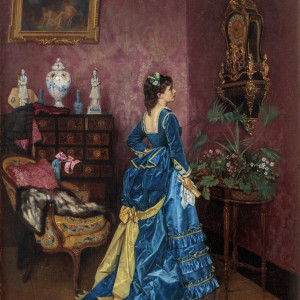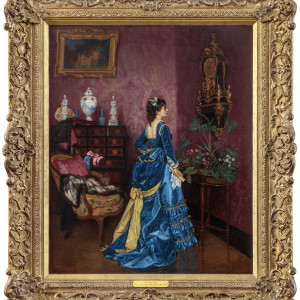Our painting begs some questions: Why is she looking at the clock in angst? Is she waiting for a visitor? Is she going on a romantic rendezvous?
Provenance
Sale: Christie’s, New York, 26 October 2005, lot 180, as The Blue dress
Acquired by the present owner at the above sale
Catalogue note
“Examine each fold of the dress, and each figure of the lace pattern. Admire the cabinetmaker’s skill in working out such charming designs, and the decorator’s in painting the walls. Mark the exquisiteness of taste that gives one the very richest upholstery, and costumes of satin and velvet.” (Jessie Wentworth, The Repository, Vol. 52, 1874, p. 220). One can almost imagine that the author of this contemporary review was standing in front of Toulmouche’s Lady in a blue dress. Fashion was a popular topic and took on a newfound prominence in 19th century Paris, and the chic Parisienne became a favored subject among many artists, including Edouard Manet, Alfred Stevens and Auguste Toulmouche.
In our Lady in a blue dress, emphasis is placed on the bright blue folds of the elegant velvet gown. The large satin ribbon tied in the back just below the pouf and the laced square-cut shoulder décolleté are the absolute chic. The model is also surrounded by the most recent trends in interior design. The rich burgundy silk wall coverings complement the sapphire of her dress, while the blue and white porcelain placed over the chest of drawers in the background echo the vogue for Japanism, a craze for Japanese art and design that swept France in the late 19th century.
With his eye for young women clad in the latest fashions and placed in elegant interior settings, Toulmouche was also a storyteller. His seemingly idle subjects have in fact greater depth. While our model does not represent a specific individual, she remains universal and timeless in her expression of longing and mystery. Our painting begs some questions: Why is she looking at the clock in angst? Is she waiting for a visitor? Is she going on a romantic rendezvous?




